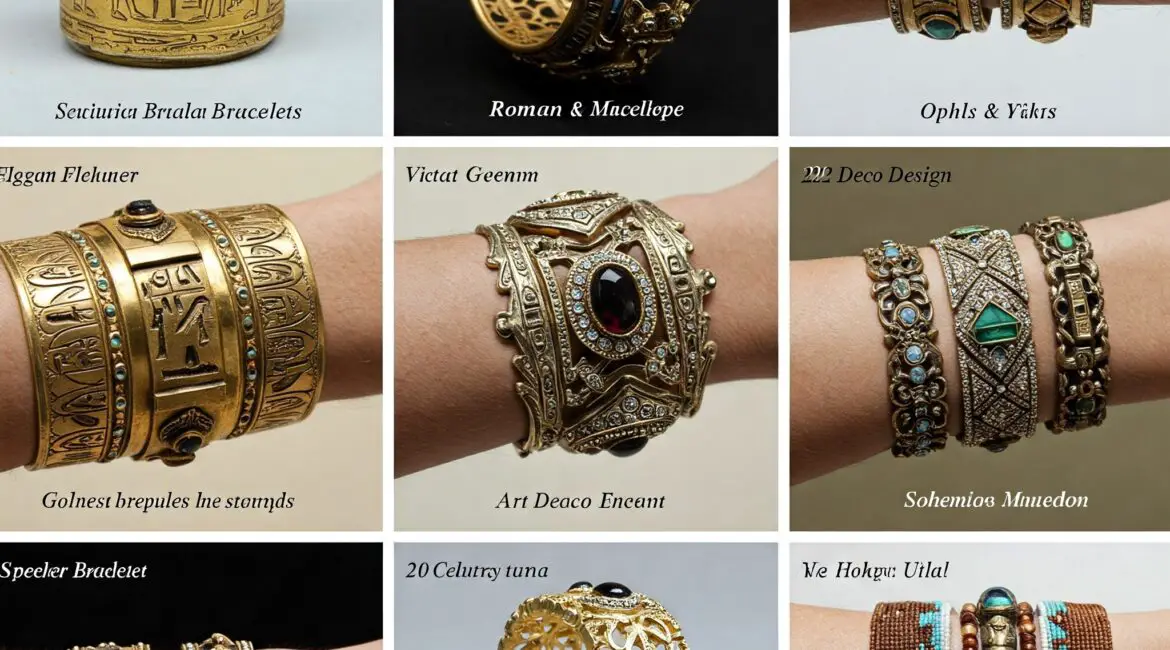Bracelets have been a part of human culture for centuries, serving as symbols of status, beauty, protection, and identity. From ancient civilizations to the modern fashion trends we see today, bracelets have always had a significant place in our wardrobes. Whether you’re sporting a sleek metal bangle or an intricate leather wrap, every bracelet tells a story that reflects its wearer’s culture, style, and history.
In this article, we’ll take you on a journey through the fascinating evolution of bracelets, from their origins in ancient times to their place in today’s fashion world.
1. Ancient Beginnings: Symbolism and Protection 🌍
When it all began:
Bracelets have been worn since ancient times, with some of the earliest examples dating back to the prehistoric era. Archaeologists have found evidence of jewelry made from shells, bones, and stones worn by early humans. These simple adornments were likely used as symbols of protection or as charms to ward off evil spirits. 🦸♀️✨
In ancient Egypt, bracelets were often made of gold, silver, and precious stones, and they symbolized wealth and power. Pharaohs and noblemen adorned themselves with elaborate jewelry, including armlets and cuffs, which were often inscribed with hieroglyphics or symbols of gods. 🌟
Cultural significance:
In many ancient cultures, bracelets also held deep spiritual meaning. For example, in the Roman Empire, soldiers wore leather bracelets (called “fibulae”) that were believed to offer protection in battle. Similarly, in ancient India, bracelets made of metal were worn as amulets, believed to bring good fortune and health. 🏺🧿
2. The Middle Ages: Prestige and Symbolism ⚔️
Jewelry as status:
During the Middle Ages, bracelets became more elaborate, especially among the aristocracy. They were often crafted from precious metals such as gold and silver and adorned with intricate designs or gemstones. A bracelet’s material and craftsmanship were indicators of social status, with the wealthier classes wearing more luxurious pieces. 🏰💎
The rise of Christianity:
In Europe, Christian influences led to the creation of religious bracelets, such as those featuring crosses or other sacred symbols. Pilgrims also wore bracelets made from leather or wood as a sign of devotion or to commemorate their journeys to holy sites. ✝️
3. The Renaissance: Artistic Expression and Fashion 🎨
The age of rebirth:
During the Renaissance period, bracelet design took a more artistic turn. Jewelry became a means of self-expression, with designs influenced by classical antiquity. Artists and jewelers in Italy and France created detailed, ornate bracelets that were worn by royalty and the elite. 💍🎨
Gold and gemstones:
The use of gold, silver, and gemstones became more prominent during this era. Precious stones like diamonds, rubies, and emeralds were incorporated into bracelets, and they were often designed to highlight intricate craftsmanship. These pieces were not just about status anymore; they became works of art in their own right. 🏰💎
4. The Victorian Era: Romanticism and Mourning Jewelry 🖤
Mourning bracelets:
The Victorian Era (1837–1901) brought about a unique trend in bracelet design. Mourning jewelry became popular, where individuals wore bracelets made of jet, onyx, or black enamel to commemorate the loss of a loved one. These pieces were often engraved with the deceased’s initials, names, or symbols of death such as skulls or urns. ⚰️💀
Romantic jewelry:
On the other hand, bracelets also became symbols of romance during the Victorian period. Lovers exchanged intricately designed bangles, and sentimental charms were added to bracelets as tokens of affection. The famous “love tokens” were inscribed with messages of love and given to partners as expressions of devotion. 💘
5. The 20th Century: Fashion Revolution and Personalization 💫
Art Deco and the Roaring Twenties:
In the early 20th century, bracelets saw a major evolution with the rise of Art Deco design. This style was characterized by bold, geometric shapes and the use of materials such as platinum, diamonds, and other precious gems. The Roaring Twenties embraced excess, and bracelets became statement pieces that added glamour to a woman’s attire. 🎉💎
Charm bracelets and personalization:
In the mid-20th century, charm bracelets became incredibly popular. These bracelets were adorned with small charms, each representing something personal or significant to the wearer. Charm bracelets allowed for individualization and personalization, and they became a staple in many women’s jewelry collections. 🛍️🔮
6. Modern Day: Trendy, Minimalistic, and Bold 🌟
Fashion meets function:
Today, bracelets are more versatile than ever. Whether you’re wearing a simple minimalist cuff, a stack of bangles, or a personalized charm bracelet, the variety of designs available caters to every taste. Minimalism is a huge trend right now, with sleek, geometric bracelets gaining popularity. These simple designs allow the wearer to add a touch of elegance without overwhelming their outfit. 👗✨
Stacking and mixing materials:
Another modern trend is the art of stacking bracelets. Mixing materials like leather, metal, and beads has become a popular way to create a unique and layered look. These bracelets are often worn casually with everyday outfits, but they can also be styled for more formal occasions. 💖📿
Sustainable and eco-friendly bracelets:
As sustainability becomes a more important consideration in fashion, many designers are focusing on creating eco-friendly bracelets using recycled materials or ethical production methods. These bracelets allow the wearer to make a statement about their commitment to the environment while still looking stylish. 🌿♻️
Conclusion: Bracelets Through Time ⏳
From ancient Egypt to modern fashion runways, bracelets have evolved from symbols of protection and status to pieces of personal expression and style. Whether worn for their symbolic meaning, aesthetic appeal, or as a statement of individuality, bracelets have stood the test of time as a timeless accessory. 💎
As trends continue to change and evolve, one thing remains constant—bracelets will always be an essential part of fashion, offering endless ways to express personal style and creativity. ✨


